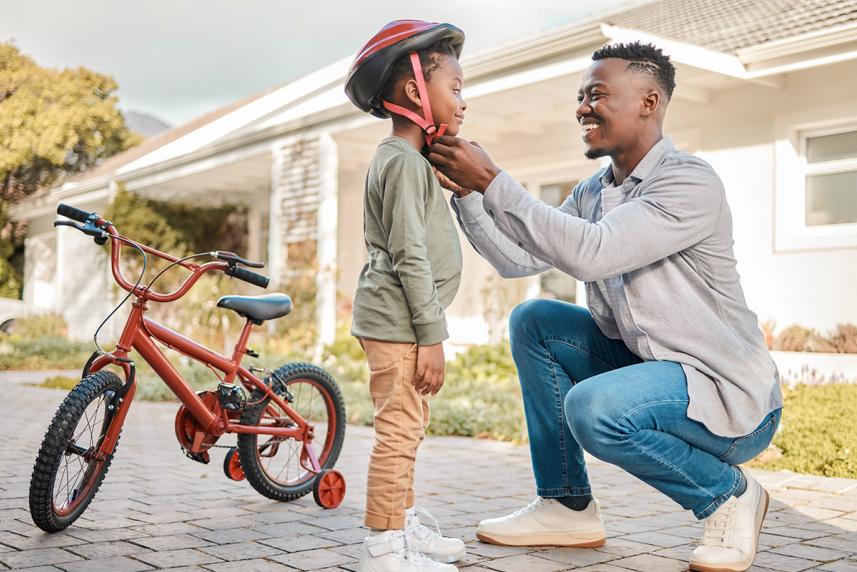
Work with a therapist through one of Refresh Mental Health’s centers, now offering virtual care and services at more than 300 places nationwide.

You’d do anything to keep your child safe. Follow these tips to protect them from falls and head injuries.
This much we know: Kids are going to be kids. They’re going to run around and play. They’re going to go biking and sliding and seesawing. And they’re going to fall.
That part about kids falling can be scary for them. And for you as a parent too. If your child falls and scrapes their knee, you can usually handle it with a small bandage. But it can be even more scary if they fall and hit their head.
It’s not just falling. Kids can also hit their heads by running into things or playing sports.
Head injuries in children happen more often than you might think. Emergency rooms see 564,000 kids with bumped heads each year.1 Sports injuries and car accidents are other common causes of childhood head injuries.
You can’t be there to prevent every fall or injury. But you can learn how to keep your kids safe. And if they do get a head injury, it’s important that you know what to do. Here are the 4 top facts you need to know when you’re caring for a child.

Work with a therapist through one of Refresh Mental Health’s centers, now offering virtual care and services at more than 300 places nationwide.
You may hear people use the terms “head injury,” “brain injury” and “concussion.” They’re quite a bit different. Here’s how to tell the difference:
Let’s say you’re at the playground with your preschooler. She trips and hits her forehead. She’s upset, but she seems fine after you comfort her. What do you do?
It’s a good idea to check in with your child’s doctor just in case.3 Most head bumps in kids don’t cause serious problems. But the doctor will want details about the injury and how your child is feeling.
“When I’m on call, I hear from a worried parent almost every night,” says Dr. Good. Your doctor might suggest you use a cold compress if there’s a bruise, or a bandage if there’s a small cut.
And they’ll have you keep an eye on your child for a period of time. That’s to make sure your child’s behavior doesn’t change. A change in behavior could include a shift in your child’s personality, or your child acting more (or less) emotional than usual.
Stock up on all your health essentials. Optum Store has the products you love at everyday low prices. Use your HSA/FSA dollars to save even more. Shop now.
Let’s say your child knocked heads with another kid at soccer. He felt fine after the game. But later that afternoon, he complains that he has a headache.
That might be a sign of something more serious. That’s because not all symptoms of brain injuries show up right away.
Some symptoms may take hours or even days to show up. And some might not seem like symptoms at all and can be easy to overlook. Depending on your child’s age, they might not be able to tell you what’s wrong.
You’ll want to watch for signs of a concussion, like:2,3,4
In rare cases, your child might have worse symptoms. Call 911 if they lose consciousness, have a seizure or start vomiting.
You can’t keep your child safe from every fall or accident. But you can take steps to keep them safe. Here are some important ways to protect their head and their brain:
Use car seats and booster seats. Use age- and size-appropriate car seats and booster seats. It can help protect them from head or brain injuries. All kids should ride in the rear seat until age 13.5 Keep these points in mind:
Make sure kids wear helmets. A helmet can help keep your child safe from a head injury or brain injury. Your child should always wear a helmet when they ride a bike, scooter or skateboard. Check that the helmet fits snugly and does not slide around on their head.6
Make helmets a habit from the time your child first learns to ride a scooter or bike. “Parents need to be good role models as well,” says Dr. Good. Kids don’t miss much. They may not want to wear a helmet if their parents aren’t wearing one.
Kids should also wear helmets when they ski, snowboard or go sledding. And helmets are important when they play certain team sports such as football, hockey, softball and baseball.
Childproof your home. If you have a young child, take steps to childproof your home to protect against falls. Make sure windows aren’t easily opened. Place safety gates at the tops of stairs. Use corner and edge bumpers on coffee tables and other low furniture. Keep one hand on your child on the changing table so they don’t fall.
And don’t let them jump on their bed. Will they be happy about that? Probably not. But you’ll know you’re keeping them safe.
Sources
© 2024 Optum, Inc. All rights reserved. Do not reproduce, transmit or modify any information or content on this website in any form or by any means without the express written permission of Optum.
The information featured in this site is general in nature. The site provides health information designed to complement your personal health management. It does not provide medical advice or health services and is not meant to replace professional advice or imply coverage of specific clinical services or products. The inclusion of links to other websites does not imply any endorsement of the material on such websites.
Stock photo. Posed by model.